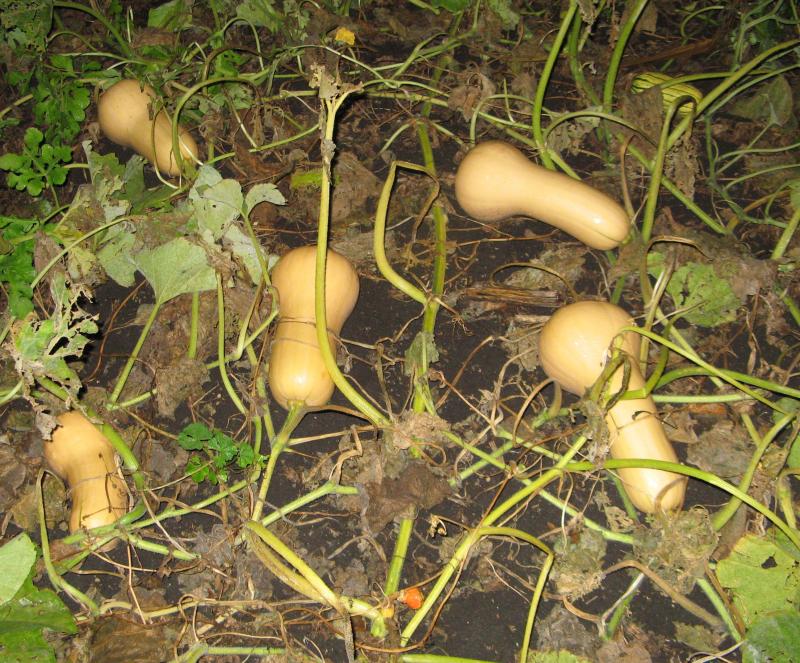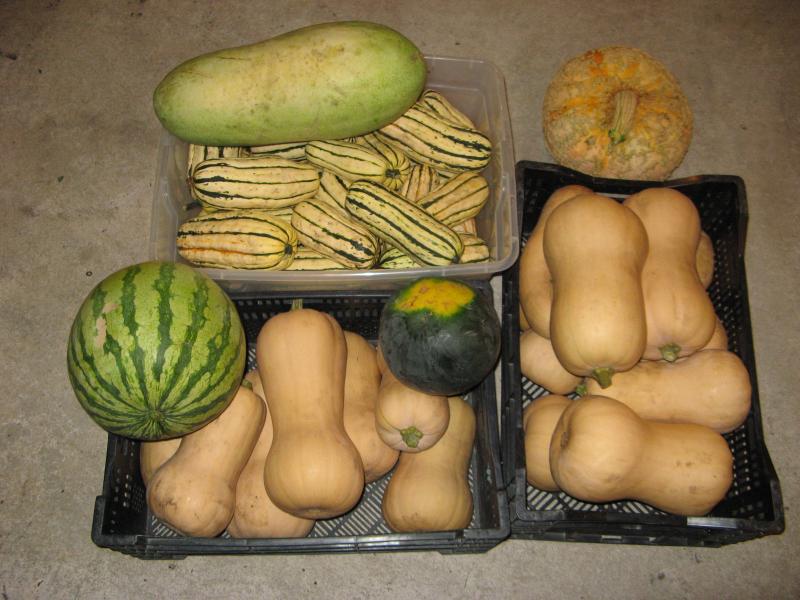One of the wonderful things about having a vegetable garden is having access to fresh produce all season long. Now that the growing season is closing down, you likely still have some vegetables left to harvest, particularly the winter squash. The great thing about squash is that they usually store well so they can provide food for several months during the fall and winter.
Winter squash, and other cucurbit relatives like pumpkins, melons and gourds, generally need a fairly long growing season to mature, often 95 to 120 days for winter squash. Cool weather can delay fruit development and maturation so in some years, we might be cutting it pretty close to get the squash fully matured before a freeze shuts them down. The cool and wet spring weather we had this year, delayed planting and germination so some of those later maturing varieties might not get as ripe as we would want. If the fruit is harvested before it is fully ripe, it will usually not store as well and will have poorer flavor than a fully ripe fruit.

Most winter squash give you some cues to know when the fruit are fully ripe or mature. The first thing to check is the hardness of the shell of the fruit. Generally, the shell should be so hard as to make it difficult to make an impression with your finger nail. Consider the color of the fruit. Most types will develop a duller appearance but have the full color of that variety when fully ripe. Another good sign to look for is the development of a ground spot. A ground spot often develops on the fruit where it has been sitting on the ground. This spot will often be a different color then the rest of the fruit. In the case of dark colored squash like acorn, turbin or ‘Delicata’, it is often an orange or yellow patch. On lighter skinned fruit, like butternut, it may be a white patch.
Most winter squash have pretty good frost tolerance, as long as they don’t get exposed to a hard freeze where the temperature might get down to 28° for more than a couple hours. If a heavy frost or freeze is predicted, you can cover your squash with old blankets or a tarp to provide some protection. A frost can make it easier to harvest because the leaves will collapse first giving you a better chance to see all the fruit that have developed, making harvest and even walking through the patch much easier. I prefer to cut the stem of each fruit with a pruning shears instead of just breaking it off. If the stem breaks off right at the fruit, this can create a wound where fungi or bacteria can get in and cause rot.

Sort through the fruit you harvest and set aside any fruit that is cracked or has insect damage because they will not store well but could be eaten first. I like to use a forceful jet of water to get rid of most of the mud or dirt. Then, I let them dry before I pack them up in tubs, baskets or crates. I store them in my garage that I keep heated to about 40°during the winter. The squash will store quite well in that location but I have to watch out that the garage doesn’t cool off too much during a cold spell. If the fruit freeze, they will generally not store well after that. You should also check the fruit occasionally. You have heard the expression that one rotten apple can spoil the whole bunch; well the same type of thing can happen with squash too.
Once you have harvested all of the fruit that you want, it is a good idea to do some garden sanitation and get rid of the vines. If you can pull them off the garden with most of the leaves still attached, you can help to remove disease pathogens and squash pests like vine borers, cucumber beetles and squash bugs that might try to overwinter in the old plant debris or in the soil beneath the vines. The vines and old leaves can be tilled or plowed into the soil too but they can also wrap around the blades of a rototiller and be a real pain to get unwrapped again. I prefer to pull or rake them into a pile, let them dry out then burn them to get rid of them.
Squash are a long season crop but, I think, one that is certainly worth the wait. There are probably hundreds of different kinds of winter squash that come in many shapes, sizes and colors. They can even be used for fall decorations. Different squash have different flavors too. It may take you some time to find your favorites. So try growing different kinds each year or check out what is available at your local Farmers Market or ask if any of your gardening friends have a favorite and some fruit to share. Squash is a nutritious vegetable and a great way to extend the bounty of your garden into the winter months.


